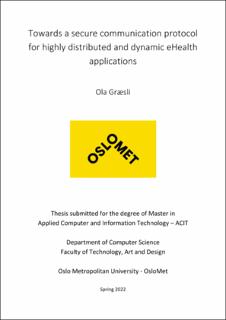| dc.description.abstract | Demand for electronic health care systems is increasing. In addition to this, more of the systems benefit from being accessible outside of the physical organizations. This is also something that gives users better decision support, which in turn is beneficial for the patients. Health care systems have high demands for information security and are regulated by laws and regulations. Communicating sensitive information forces the systems to prevent unintended data access and unauthorized modifications. Such breaches might be fatal to patients in acute situations. At the same time, there is a demand for availability of data. The thesis focuses on the use case of an ambulance handling situations outside the organization to assess this.
The thesis suggests a model for secure communication of data in health care systems in distributed and dynamic applications. Legal requirements, official standards, and best practices will be evaluated to do this. The suggested model contains central parts of such systems and is intended as a basis for implementation in different types of systems. The options for each of the selected parts in the suggested model are evaluated using an expert review based on the acquired information.
Based on an overview of a general health care system, the selected parts for the suggested model are communication over the different networks, encryption of messages, and authentication and governance of external clients. The expert review of these parts resulted in a socket-based communication directly between the external clients and the central system. To encrypt the messages, AES was selected to ensure the confidentiality of data. A system with private and public keys for the central system and the external clients is used for authentication and governance. By signing the encrypted messages with the receivers’ public key, the receiver can verify that the message is from the sender and is not modified. A simple proof of concept implementation tests the combination of the different parts and exchange of messages.
The suggested model creates a platform for possible implementations in both new and existing systems. Parts of the model are according to laws and regulations and follow most of the suggested standards and best practices. It also seems to fulfill the discovered requirements by the end-users. The model is created based on limited time and resources, which means that more research probably will improve the model further. This might be needed to make this a recognized standard for such communication. Because the model consists of multiple parts, it is possible to adjust some of these and still use many of the suggestions for the rest of the model. At the same time, the suggested model is tested and will work as intended. Therefore, it is possible to implement it in a system and try to get the system approved. Because the model is not created in association with a specific organization, it is not verified that it will be accepted by the responsible for information security in a particular organization. | en_US |
